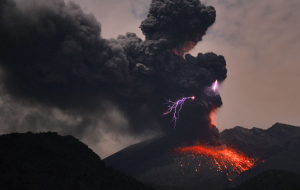
Credit: Martin Ritze
Ludwig Maximilian University of Munich researchers have shown that volcanic lightning results from the discharge of static electricity accumulated by ash particles in the rising plume. Observations of such flashes could help to forecast the impact of volcanic eruptions.
Mount Sakurajima on the Japanese island of Kyushu is one of the most active volcanoes in the world. The huge clouds of gas, ash and rock fragments which the volcano spews into the atmosphere during its highly explosive eruptive phases are often illuminated by volcanic lightning – a striking phenomenon that remains poorly understood. Volcanologist Corrado Cimarelli and his group in the Department of Earth and Environmental Sciences at LMU recently made a detailed study of the lightning flashes that accompany Sakurajima’s frequent outbursts.
The team now reports that friction generated by collisions between the ash particles in the turbulent jets that form the plume invests the particles with sufficient electrostatic charge to account for the lightning observed during eruptions. They also show that the frequency of the flashes varies with the amount of ash emitted during an eruption. This correlation suggests that monitoring of volcanic lightning could provide a means of determining the size distribution of the ash clouds released into the atmosphere during eruptions – and permit improved forecasting of their potential impact on air traffic. The findings appear in the journal Geophysical Research Letters, and the work is featured on the cover of the latest issue.
“We used video footage of eruptions of Sakurajima obtained with a high-speed camera as the basis for our study, and combined these images with measurements of changes in the electromagnetic field and with data recorded by acoustic sensors,” says Cimarelli. Analysis of the resulting data allowed the researchers to determine that volcanic lightning flashes are largely restricted to the lower levels of the plume, i.e., within a few hundred meters above the crater’s rim. In this region, particle fragmentation within the turbulent magma electrifies the rising ash particles, and the accumulated electrostatic charge is subsequently explosively discharged in the form of lightning. In contrast to normal lightning which originates at greater heights, volcanic lightning flashes do not require the presence of ice crystals as nucleation centers.
The researchers argue convincingly that monitoring of volcanic lightning would facilitate assessment of the overall impact of volcanic eruptions: “Independently of the size of the eruption, every episode of ash emission is associated with electrical discharges,” says Cimarelli. “This is a parameter that can be measured – from a distance of several kilometers away and under conditions of poor visibility – and it can be used as a proxy to estimate the total mass and the size distribution of the ash deposited in the atmosphere. This would enable us to rapidly assess the distribution of ash particles in the atmosphere and if necessary alert the aviation authorities.”
Reference:
C. Cimarelli et al. Multiparametric observation of volcanic lightning: Sakurajima Volcano, Japan, Geophysical Research Letters (2016). DOI: 10.1002/2015GL067445
Note: The above post is reprinted from materials provided by Ludwig Maximilian University of Munich.









